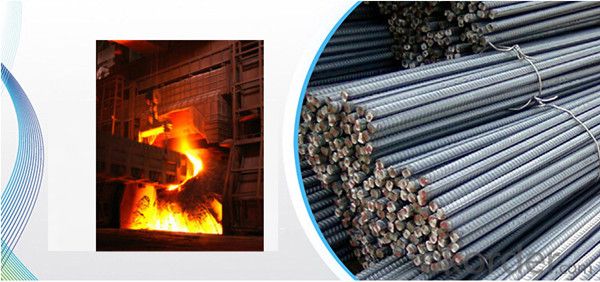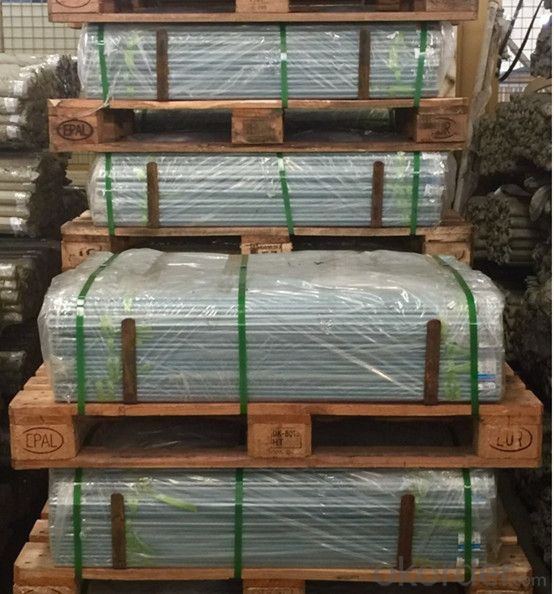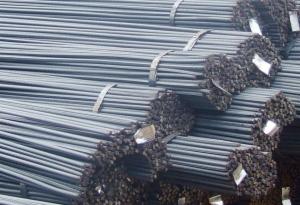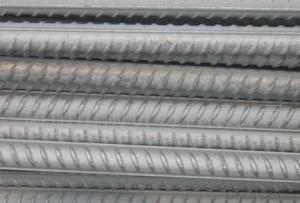HRB 400/ 500 Reinforcing Deformed Steel Round Bar with Cheap Price
- Loading Port:
- Tianjin
- Payment Terms:
- TT OR LC
- Min Order Qty:
- 100 m.t.
- Supply Capability:
- 100000 m.t./month
OKorder Service Pledge
OKorder Financial Service
You Might Also Like
Specification
HRB 400/ 500 Reinforcing Deformed Steel Round Bar with Cheap Price
Products Description:
1. Diameter: 5.5mm-10mm rounds reinforcing steel bar
10m- 40 rods reinforcing deformed steel bar
2. Length: 6m, 9m, 12m or customized
3. Standard: GB, ASTM, AISI, SAE, DIN, JIS, EN. OEM technology - send detailed technical parameters for accurate quotation.
4. Produce Process: smelt iron - EAF smelt billet - ESR smelt billet - hot rolled or forged to get the steel round bar and plate
5. Heat Treatment: annealing, normalizing, tempering, quenching
6. Surface Treatment: Black
7. Quality Assurance: We accept third party inspection for all orders.
You can ask testing organizations such as SGS, BV, etc. to test our products before shipping.
Theoretical weight and section area:
| Diameter(mm) | Section area (mm²) | Mass(kg/m) | Weight of 12m bar(kg) |
6 | 28.27 | 0.222 | 2.664 |
| 8 | 50.27 | 0.395 | 4.74 |
| 12 | 113.1 | 0.888 | 10.656 |
| 16 | 201.1 | 1.58 | 18.96 |
| 20 | 314.2 | 2.47 | 29.64 |
| 25 | 490.9 | 3.85 | 46.2 |
| 32 | 804.2 | 6.31 | 75.72 |
| 40 | 1257 | 9.87 | 118.44 |
| 50 | 1964 | 15.42 | 185.04 |
Technical Datas:
Grade | Technical data of the original chemical composition (%) | |||||
| C | Mn | Si | S | P | V | |
| ≤0.25 | ≤1.60 | ≤0.80 | ≤0.045 | ≤0.045 | 0.04-0.12 | |
HRB400 | Physical capability | |||||
| Yield Strength (N/cm²) | Tensile Strength (N/cm²) | Elongation (%) | ||||
| ≥400 | ≥570 | ≥14 | ||||
Products Show:





Packages and Shipping:


FAQ:
1. Your advantages?
Professional products inquiry, products knowledge train (for agents), smooth goods delivery, excellent customer solution proposale
2. Test & Certificate?
SGS test is available, customer inspection before shipping is welcome, third party inspection is no problem
3. Payment Terms?
30% TT as deposit and 70% before delivery. Or Irrevocable L/C at sight.
4. Trading Terms?
EXW, FOB, CIF, FFR, CNF
5. After-sale Service
We provide the services and support you need for every step of our cooperation. We're the business partner you can trust. For any problem, please kindly contact us at any your convenient time.
- Q: Are steel rebars suitable for use in high-temperature applications?
- High-temperature applications are generally not suitable for the use of steel rebars. Despite being a strong and durable material, steel has limitations when exposed to high temperatures. It can undergo a significant reduction in strength and even a loss of structural integrity, leading to potential failures. When subjected to high temperatures, steel goes through a process known as thermal expansion, which can weaken and deform it. This phenomenon is particularly noticeable in rebars, which are commonly used to reinforce concrete structures. The high temperatures cause the rebars to expand, exerting excessive pressure on the surrounding concrete. This pressure can result in cracks and potentially compromise the stability of the structure. Furthermore, prolonged exposure to high temperatures can cause a loss of the steel's mechanical properties, including its tensile strength and load-bearing capacity. As a result, the rebars become less effective in resisting external forces and reinforcing the concrete. For this reason, it is generally recommended to consider alternative materials, such as stainless steel or special alloys, for high-temperature applications. These materials are specifically designed to withstand elevated temperatures without compromising their structural integrity. To ensure safety and structural stability, it is important to consult with experts and engineers who are familiar with high-temperature applications in order to determine the most suitable materials for specific projects.
- Q: What is the average tensile strength of steel rebars?
- The average tensile strength of steel rebars typically ranges from 400 to 600 megapascals (MPa).
- Q: Are steel rebars suitable for use in earthquake-resistant structures?
- Yes, steel rebars are suitable for use in earthquake-resistant structures. Steel rebars, also known as reinforcing bars, are commonly used in construction to provide structural strength and reinforcement. They have been proven to be effective in improving the strength and ductility of concrete structures, making them more resistant to seismic forces. During an earthquake, structures are subjected to intense shaking and ground motion. Steel rebars help in distributing and dissipating the energy generated by these seismic forces, thereby reducing the vulnerability of a structure to damage or collapse. The use of steel rebars enhances the overall structural integrity and stability, enabling buildings and other infrastructure to withstand the lateral and vertical forces associated with earthquakes. Moreover, steel rebars possess excellent tensile strength, which is crucial for seismic resistance. Unlike concrete, which is strong in compression but weak in tension, steel rebars provide the necessary reinforcement to counteract tensile stresses caused by seismic activity. This ability to resist both compression and tension makes steel rebars an ideal choice for earthquake-resistant structures. Additionally, steel rebars can be designed and installed in such a way that they provide additional ductility to a structure. Ductility refers to a material's ability to undergo deformation without fracturing. During an earthquake, structures with higher ductility can undergo significant deformations and absorb energy, reducing the risk of catastrophic failure. Steel rebars are known for their high ductility, allowing them to effectively absorb and dissipate seismic energy. In conclusion, steel rebars are highly suitable for use in earthquake-resistant structures. Their strength, ability to resist both compression and tension, and high ductility make them an essential component in ensuring the structural integrity and safety of buildings and infrastructure in seismic-prone areas.
- Q: Are steel rebars prone to bending or warping?
- Under normal conditions, steel rebars do not typically bend or warp. Their purpose in construction projects is to reinforce concrete structures, as they possess high tensile strength. These rebars are crafted from durable materials like carbon steel, enabling them to bear heavy loads without deforming. Nevertheless, it is crucial to acknowledge that external factors, such as excessive heat or improper handling during transportation and storage, can potentially cause rebars to bend or warp. Exposure to high temperatures compromises the structural integrity of steel rebars, rendering them more susceptible to deformation. Similarly, mishandling or inadequate storage practices, like uneven stacking or placing heavy objects on top, can result in deformation. To guarantee the structural integrity of steel rebars, it is vital to adhere to proper handling and storage guidelines, while also ensuring they are utilized within specified load limits. Moreover, considering the environmental conditions in which the rebars will be employed is essential for minimizing the risk of bending or warping.
- Q: What is the process of reinforcing concrete columns with steel rebars?
- To ensure the structural integrity and strength of concrete columns, the process of reinforcing them with steel rebars involves several steps. Initially, the required load-bearing capacity and other structural considerations are taken into account to determine the design and specifications of the concrete column. This involves deciding on the size, shape, and placement of the rebars within the column. Following this, temporary molds or frameworks in the desired shape and dimensions of the column are constructed as part of the concrete formwork preparation. These molds provide support and containment for the concrete during the pouring and curing stages. Once the formwork is ready, the steel rebars are meticulously positioned and fastened within it. They are typically arranged in a specific pattern to maximize reinforcement and strength, including vertical bars running along the length of the column and horizontal bars that wrap around the vertical ones. To maintain their position and prevent movement during the pouring of the concrete, the rebars are often tied together at intersections using wire or other fasteners. This ensures that the rebars are effectively embedded within the concrete and can properly reinforce the column. Once the rebars are securely in place, the concrete is poured into the formwork. The concrete mixture is carefully applied and consolidated to fully surround and encase the rebars, creating a composite material that is more resistant to cracking and deformation. After the concrete is poured, it is left to cure and harden, typically for a period of several days or weeks. This allows the concrete to gain strength and durability, ensuring effective bonding between the rebars and the concrete and enabling the column to bear the intended loads. Once the concrete has fully cured, the formwork is removed, revealing the reinforced concrete column. The rebars should be completely embedded within the concrete, providing additional strength and support to withstand the applied loads. In summary, reinforcing concrete columns with steel rebars involves careful planning, positioning, and securing of the rebars within the formwork, followed by the pouring, curing, and removal of the formwork. This process guarantees that the resulting reinforced concrete column is structurally sound and capable of withstanding the intended loads and forces.
- Q: Are there any disadvantages of using steel rebars in construction?
- Yes, there are some disadvantages of using steel rebars in construction. One major drawback is that steel is prone to corrosion, especially in humid or coastal areas, leading to structural deterioration over time. Additionally, steel rebars are heavy and require specialized equipment for transportation and installation, which can increase construction costs. Lastly, steel production has a significant environmental impact due to the extraction and processing of raw materials, contributing to carbon emissions and depletion of natural resources.
- Q: Can steel rebars be used in parking structure construction?
- Using steel rebars in parking structure construction is a common practice. They provide strength and durability to reinforced concrete structures. The use of steel rebars is especially important in parking structures due to the heavy loads and traffic they experience. These rebars are typically placed in the concrete slabs, walls, and columns of the structure, improving its load-bearing capacity and resistance to compression, tension, and bending. Additionally, steel rebars can also reinforce ramps, driveways, and other areas that require extra support. Overall, incorporating steel rebars is crucial in parking structure construction to comply with safety standards and ensure the facility's longevity.
- Q: Can steel rebars be used in corrosive chemical environments?
- No, steel rebars should not be used in corrosive chemical environments as they are susceptible to corrosion which can compromise their structural integrity.
- Q: How do steel rebars comply with building codes and regulations?
- Steel rebars comply with building codes and regulations by meeting specific requirements outlined in these codes. These requirements include the dimensions, strength, and quality of the rebars, as well as their placement and spacing within the concrete structures. Compliance is ensured through rigorous testing and certification processes, ensuring that the rebars meet the necessary standards for safety and structural integrity in construction projects.
- Q: How are steel rebars affected by temperature fluctuations?
- Steel rebars are affected by temperature fluctuations in several ways. Firstly, when exposed to high temperatures, steel rebars can expand, which can lead to cracking and weakening of the structure they are supporting. On the other hand, in extremely cold temperatures, steel rebars can contract, potentially causing stress and cracking. These temperature fluctuations can also impact the overall durability and longevity of the rebars, potentially reducing their structural integrity over time. Therefore, it is crucial to consider the effects of temperature fluctuations when designing and constructing structures with steel rebars to ensure their long-term stability and safety.
Send your message to us
HRB 400/ 500 Reinforcing Deformed Steel Round Bar with Cheap Price
- Loading Port:
- Tianjin
- Payment Terms:
- TT OR LC
- Min Order Qty:
- 100 m.t.
- Supply Capability:
- 100000 m.t./month
OKorder Service Pledge
OKorder Financial Service
Similar products
Hot products
Hot Searches
Related keywords
































